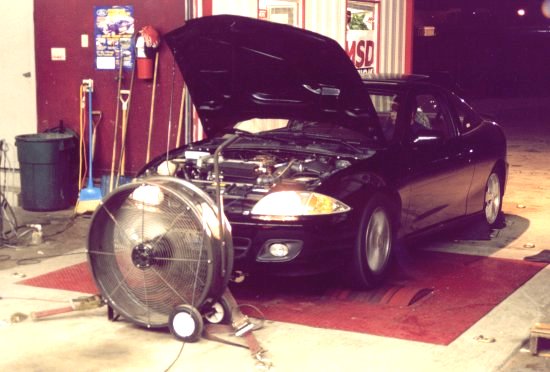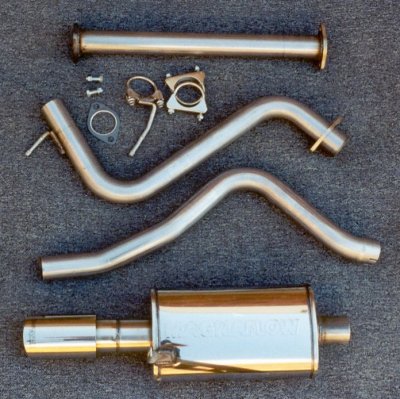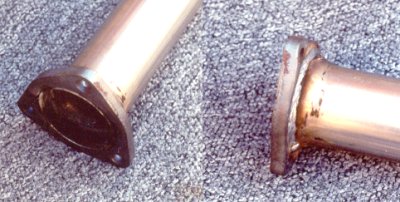

Iperformance; Dyno Testing and Comparison of Cat Back Exhaust Systems for
1996-2002 Chevrolet Cavalier and Pontiac Sunfire
Background
As would be expected, just as with the Isuzu community, there is quite a bit of debate concerning what particular type and which brand cat back exhaust system works best on the Chevrolet Cavalier and Pontiac Sunfire. We have already terminated this debate among the Isuzu community with our dyno test comparison of 2 1/4 inch Pacesetter and 2 1/2 inch Iperformance exhaust systems for 1990-93 Isuzu and Geo Storm cars. We decided to go ahead and run the same test comparison on the 1996-2005 Chevrolet Cavalier and Pontiac Sunfire, so that we could test a couple examples of cat back exhaust systems for these vehicles, side by side, on a dynamometer, and establish which system worked better.
To accomplish this, we came to an agreement with Mustang Muscle Performance and Dyno Service in High Ridge, Missouri, to use their DynoJet Dynamometer to measure performance.
We were lucky enough to find a volunteer locally, Lenny Kean of Wentzville, Missouri, who graciously donated the use of his 2001 Chevrolet Cavalier Z24 car for the testing. Lenny's car is basically stock, the only modifications being a fiberglass hood, Eibach lowering springs, and a polished stainless steel straight through type muffler spliced onto the stock piping in place of the original equipment chambered muffler. We would return the car to the stock pipe with the stock muffler for the baseline numbers, but not after we ran the car on the dyno with Lenny's setup which we quickly named "the loud muffler".
The exhaust systems to be tested were the stock cat back exhaust system, the RK Sport / Magnaflow brand single muffler cat back exhaust system, and the Iperformance brand cat back exhaust system.
Dyno testing involves parking the vehicle with the drive wheels and tires on the rollers of the dynamometer and then strapping the car down to the ground so that it will stay on those rollers while the drive wheels and tires spin them.
An inductive electrical current sensor is placed around one of the ignition wires so that the machine can measure information on power produced at each specific engine speed. For the Cavalier with the Quad Four engine, we quickly learned that we would have to un tape the wire loom where it plugs into the ignition coil pack and place the inductive sensor around the black wire which triggers the firing of the number one cylinder.
The settings of the machine are adjusted to match the gear ratios of transmission of the vehicle by correcting engine speed and roller speed to match.
Once the machinery is ready, the vehicle is accelerated through first, second, and third gears, to fourth gear, and the engine speed is held at 2,000 RPM by the operator. The operator then hits a button to begin the measurement and presses the accelerator pedal to the floor. Engine power usually is measured by the machinery at wide open throttle from or just above 2,000 RPM, all the way just short of the rev limiter. The Cavalier and Sunfire, though, have a speed limiter programmed into the engine control computer, which cuts off the ignition once the car reaches a point just about 105-108 MPH. The car, will, of course, easily reach this speed in fourth gear, and our testing was limited to the engine speed just above 2,000 RPM to 5,600 RPM, where the speed limiter kicked in when the tires reached 108 MPH on the dyno rollers.
The machinery measures the air temperature, humidity, and barometric pressure, so that it can correct the results for the atmospheric conditions. This corrects the results to SAE, which is what we have used in all of our comparisons.
In order to avoid any possible impropriety, as we are the exclusive distributor of one of the products being tested, all of the testing was conducted by Daryl, the owner of Mustang Muscle, or Matt, his son. They both have many years experience running dynamometers and had no interest in what the results of the testing were.
Dyno Chart Showing All Three Exhaust Performance Results
Baseline Numbers
We were fortunate that Lenny had his original equipment muffler and allowed us to use that for our baseline tests. We did purchase a new exhaust pipe from Chevrolet to go between the muffler and the three bolt connection behind the catalytic converter.
The stock exhaust system consists of 2 inch diameter pipe with a rather unique resonator neat the front end and a relatively common chambered muffler at the end, terminating in a Y and two steel turned down tail pipes. The pipe is squeeze bent. The resonator is interesting because from the outside, it appears to be a standard bullet style glass pack as is commonly used by auto manufacturers for resonators. This one, however, is hollow on the inside, and has a 2 inch diameter cylinder positioned lengthwise, so that the exhaust flows both through the center as well as around the sides, reducing the harsh sound of the exhaust without causing a great deal of turbulence.
Performance On The Dyno
Baseline performance was measured at a peak horsepower of 127.3 and a peak torque of 136.7 ft-lb.
The average power across the range of engine speed was 95.7 HP and 130.9 ft-lb of torque.
The real surprise was the torque curve, which stays very high across the entire range of engine speed, never falling off like other four cylinder engines.
The RK Sport / Magnaflow Single Muffler Cat Back Exhaust
Note: This exhaust system was originally branded as "RK Sport made by Magnaflow" and was available exclusively through RK Sport. It has since been made available to all retailers from Magnaflow as Magnaflow PN 15761, with a suggested retail of $821.45.
We purchased a single muffler cat back exhaust system directly from RK Sport, at retail, for this test.
Packaging
The packaging was one of the more interesting aspects of this product. The pipe and muffler had all been placed into a plastic bag and insulation foam sprayed into the box around the parts in the bag.
This did a very good job protecting the parts from anything that might puncture the box and damage them, but since the parts were not individually wrapped or padded, the pipes banged against the polished muffler and tip for probably the entire trip from California to Missouri while in transit by UPS, and as a result, the muffler was dented and there were scratches in the finish of both the muffler and the tip.
The Product
The RK Sport / Magnaflow cat back exhaust consists of four main pieces, three pipes between the three bolt flange connection and the muffler, and the muffler and tip assembly itself. Hardware included several pipe clamps, two nuts and bolts, and a gasket for the flange connection between two of the three sections of pipe.
The pipe is 2 1/4 inch diameter mandrel bent and is described by RK Sport as being stainless steel. However, if anyone was expecting the pipe to be as shiny and polished as the muffler and tip, they would be disappointed, as the pipe has the same appearance of any new exhaust pipe, unpolished, and dull. This is not of concern, it's exhaust pipe, it goes under the car, and it doesn't have to be shiny. In addition, the flanges and most of the hardware (except for two of the three pipe clamps) and the hangers, are mild steel, instead of stainless, making for a rather interesting combination of that which arrived with a bit of surface rust on it and that which will not rust.
The muffler is a Magnaflow brand muffler, with straight through design and perforated core. It is of very high quality, as are all of Magnaflow's products. The tip is rather interesting, in that it is a double wall tip, which has a 2 1/4 inch diameter inlet and gradually expands at an angle to four inches at the end of the tip, and then folds back on the outside to give the appearance that it is four inches from the muffler out. This will have some interesting implications on the sound of the exhaust system.
Something that is rather interesting is the pipe assembly which bolts to the three bolt flange at the beginning of the cat back exhaust system. For some reason, Magnaflow flares the 2 1/4 inch pipe out to 2 1/2 inches and uses a three bolt flange designed for use with 2 1/2 inch pipe. It is almost as if Magnaflow planned for their customers to use their exhaust system with headers that have 2 1/2 inch diameter collector pipes.
Overall, it's a pretty impressive exhaust system, much higher quality than we had expected.
Installation
There are no written instructions, but installing an exhaust system is fairly straight forward. Remove the original exhaust system by unbolting each piece starting from the tail pipe forward. Hang the new pieces in place from the catalytic converter to the tail pipe, but do not tighten the bolts or clamps until all the pieces are in place.
Something that RK Sport and Magnaflow might have warned us about is that they do not use the OEM muffler hanger to hold the muffler of their exhaust system in place, and, instead, the muffler bolts to the rear bumper. Everything goes into place once you figure that out, and the only real concern about the hanging of the muffler is that there is no rubber hanger to dampen the vibration of the exhaust pipe where it attaches by way of bolting the bracket onto the rear bumper stud.
Overall fit of the exhaust system is pretty good. The exhaust system being four pieces instead of three means the installer must do some juggling maneuvers to position and secure the pipes before they fall out of position.
The exhaust system seemed to hang down a lot lower than necessary, though Lenny did not say it hit anything while he was driving around with it on the car.
One big concern was that the stainless steel pipe is very stiff, and the slip joints that secure the exhaust pieces together are rather shallow. This combination led to very leaky connections and no amount of tightening in the world would stop the leaks around the connection between the second and third pipes and the third pipe and inlet to the muffler.
Cost
RK Sport Retail Price: $599.99
Magnaflow Suggested Retail Price: $821.47
Driving Around With It On The Car
Once installed, we started the car, and the sound of the engine running at idle was totally imperceptible, even in a quiet, residential neighborhood. The tone was deep, but could not be heard unless a person knelt down beside the exhaust tip to listen.
This was rather disappointing, as we expected that big chrome muffler and big chrome tip to emit a more noticeable sound at idle speed, as opposed to sounding quiet to the point that a driver in another car might pull up next to a Cavalier with the RK Sport / Magnaflow exhaust at a light and assume the car had nothing more than a chrome muffler and tip on the stock exhaust.
The exhaust sound above idle was a bit more noticeable, but not as pleasant as would be expected.
From about 2,000 RPM through 4,500 RPM, the sound is only slightly deeper in tone than a chain saw. Lenny seemed more upset with this than anyone else, saying his car sounded like a rice car. We didn't think it was quite that bad, but not as deep a tone as we are accustomed to with Magnaflow mufflers.
Lenny also commented that the exhaust was loud at highway speed when he ran the car up in gear, and that the tone at higher engine speeds remained higher in pitch than he desired.
We attribute much of the higher pitched exhaust sound as being caused by the smaller, 2 1/4 inch diameter of the pipe, which is too small for an engine of this size, and the angled walls of the exhaust tip, which do not result in as deep a tone as tips with parallel walls.
Lenny also commented that the car did not feel as strong with the RK Sport / Magnaflow exhaust system as did the stock pipe with his loud muffler. A little better than stock, but not a lot.
Performance on the Dyno
The RK Sport / Magnaflow cat back exhaust system was measured at a peak horsepower of 132.3 and a peak torque of 142.6 ft-lb. That is a increase over stock of 5.0 HP and 5.9 ft-lb of torque.
The average power across the range of engine speed was 99.4 HP and 136.2 ft-lb of torque. This is an increase of 3.7 HP and 5.3 ft-lb of torque.
The graphed performance curves on the chart show relatively consistent performance over that of the stock system from 2,100 RPM through 5,600 RPM.
The Iperformance Cat Back Exhaust
This is the exhaust system we offer for the Cavalier and Sunfire cars. The part numbers for this cat back exhaust system are SHBILL09BP (single muffler, satin finish).
There are actually several new part numbers for this exhaust system for the various 2.2 and 2.4 liter cars.
This particular exhaust system was the prototype for our 1999-2001 exhaust system.
Packaging
Although we did not ship this product to ourselves for testing, we do go to a great deal more effort to keep the Iperformance system from being damaged in shipment. The box is sized to match the product.
Each piece is wrapped in either bubble wrap or corrugated card board. The insides of the box walls and ends are lined with additional layers of corrugated cardboard as the product is being placed into the box, and any extra space is taken up with more cardboard or packing material to keep the pieces packed tightly and prevent any damage from pieces hitting each other or from the pieces breaking out the sides of the box itself.
The Product
The Iperformance cat back exhaust system consists of four pieces, a forward pipe, a center piece which goes over the rear cross member, a muffler assembly, and a turned down tail pipe. Hardware included is a three bolt catalytic converter gasket, and three U style 2 1/2 inch pipe clamps. As a result of this testing, we are going to start including three sets of nuts, bolts, and washers, to secure the exhaust system to the down pipe assembly in front of it, because the OEM system has threaded holes, requiring new nuts and bolts be used to install the exhaust system.
The pipe is 2 1/2 inch diameter aluminized steel finish.
The pipe itself measures .082 inches thick, or 14 gauge for durability and expected long life span.
The Magnaflow brand muffler is a straight through design with sound deadening material wrapped around a perforated core.
Long ago, we learned that no two Cavalier or Sunfire owners wanted the same type of tip on their exhaust system, so we resolved this by including a simple, turned down aluminized tip, that the owner could replace with anything they desired.
Installation
Again, there are no written instructions, but installing an exhaust system is fairly straight forward.
Remove the original exhaust system by unbolting each piece starting from the tail pipe forward.
Hang the new pieces in place from the catalytic converter to the tail pipe, but do not tighten the bolts or clamps until all the pieces are in place.
With three main pieces and deep slip joints, the Iperformance system did not involve any juggling and there was no worry of pieces falling.
The deeper slip joints sealed much more easily.
It was sort of odd that the larger pipe of the Iperformance exhaust system actually hung higher with more ground clearance than the smaller pipe of the RK Sport / Magnaflow exhaust system.
Cost
Aluminized: $399.00
Driving Around With It On The Car
The Iperformance cat back exhaust system had a more noticeable sound at idle speed. It was not overbearing, and was about the same volume as the original equipment exhaust, possibly a very little bit louder, and very deep in tone. It was very evident at idle speed that the car did have a performance exhaust system on it by the tone.
The exhaust sound is authoritative when the engine is above idle speed. It is deeper in tone than the weed whacker import sound and also noticeably deeper in tone than the RK Sport / Magnaflow exhaust.
Lenny was grinning from ear to ear. He said it was a little bit quieter than his loud muffler on the stock pipe, but that the car felt like it had a lot more power.
Lenny also said it sounded very good on the highway and that the car felt like it pulled much harder.
Performance on the Dyno
The Iperformance cat back exhaust system was measured at a peak horsepower of 134.9 and a peak torque of 146.9 ft-lb. The peak power gain is 7.6 HP and 10.2 ft-lbs of torque.
The Iperformance cat back shows a maximum increase of 9.0 HP at 4,600 RPM and 10.7 ft-lbs of torque at 2,600 RPM.
The average power across the range of engine speed was 101.6 HP and 139.2 ft-lb of torque. This is an average increase of 5.9 HP and 8.3 ft-lb of torque.
The graphed performance curves on the chart show consistent performance over that of the RK Sport / Magnaflow system from 2,100 RPM through 5,600 RPM, on the measure of more than 1 1/2 times the improvement of the RK Sport / Magnaflow exhaust.
There was no loss of low or mid range torque or horsepower, and the performance increase is even across the entire range without any dips below either stock level or the level of the RK Sport / Magnaflow system.
In fact, with the Iperformance cat back, there was a minimum increase of 7.4 ft-lbs of torque from 2,100 RPM all the way through 4,800 RPM, showing that low and mid range torque is precisely the area that was most improved with the system.
We expect the performance increase to widen past the tests limited engine speed of 5,600 RPM, where the speed limiter kicked in, and that the gap between the 2 1/4 and 2 1/2 inch pipe would widen as is typical, at higher engine speeds, at and above where peak horsepower occurs.
Conclusions
The Iperformance cat back exhaust system outperformed the RK Sport / Magnaflow cat back exhaust system by a rather healthy margin.
The Iperformance system picked up more than 1 1/2 times more peak horsepower and nearly double the peak torque as compared to the RK Sport /Magnaflow system.
The Iperformance system shows almost double the increase in average HP and 1 1/2 times the increase in average torque as compared to the RK Sport / Magnaflow system.
Comparing the two on the basis of dollars spent per peak horsepower gained, the RK Sport / Magnaflow system costs $119.80 per horsepower, while the Iperformance system costs $44.33 per horsepower.
The design of both systems is nearly identical, both using mandrel bent pipe and both using Magnaflow brand straight through mufflers. The performance difference being that the 2 1/4 inch pipe can not keep up with the flow requirements of the engine and can not match the results of the 2 1/2 inch pipe.
Yet again, our testing has shown that 2 1/2 inch is the proper size for any naturally aspirated four cylinder engines and 2 1/4 inch is too small.
*We have demonstrated once more, that there is no loss of mid or low range torque or horsepower when comparing 2 1/4 inch exhaust systems to 2 1/2 inch exhaust systems.The Final Word
Question:
What is the difference between the RK Sport / Magnaflow exhaust system and the Iperformance brand exhaust system?
Answer:
2.6 Peak Horsepower and 3.5 Peak Ft-Lb of Torque.
Daryl and Matt at Mustang Muscle Performance and Dyno Service have stated that they are more than happy to discuss their testing and equipment with anyone who has any questions, and they are more than happy to help if you want to dyno test your own car at their facility. They can be reached at:Mustang Muscle Performance and Dyno Service
1506 Gravois
High Ridge, MO 63049
TEL: (636) 677-9987
FAX: (636) 677-3632
Website: www.mustangmuscleonline.com







